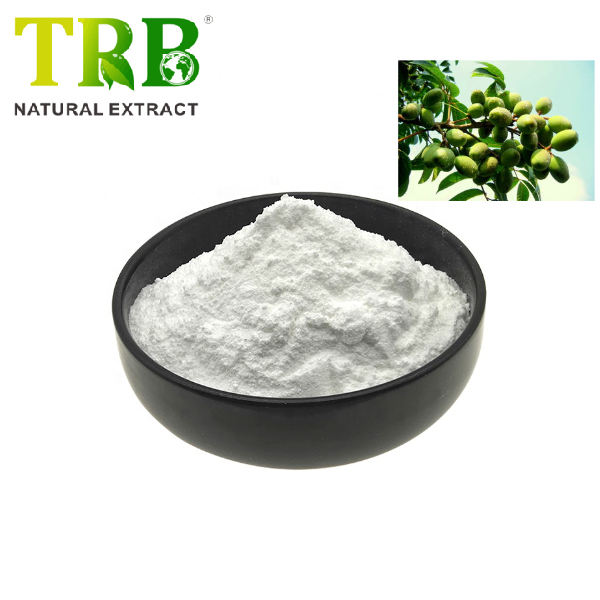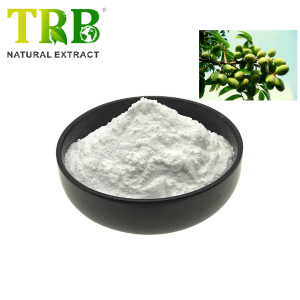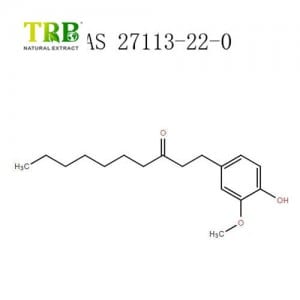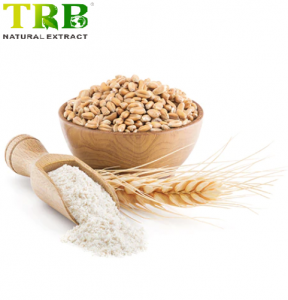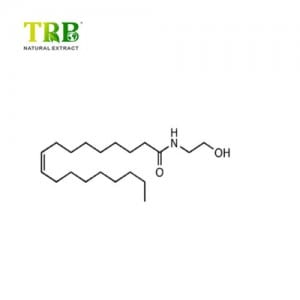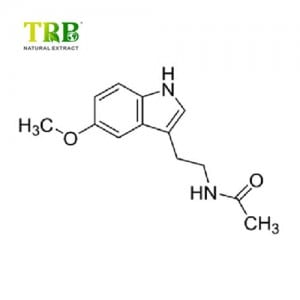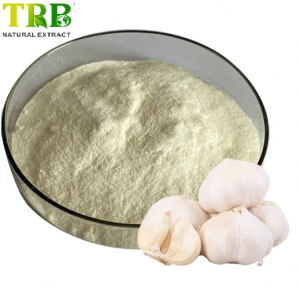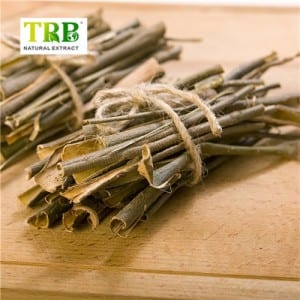Кислотаи олеанолӣ, ки се тритерпеноиди пентациклӣ мебошад, ки аз растаниҳои Gentianaceae аз Swertia mileensis тамоми алаф ё меваи приве ҷудо карда шудааст, бо бадани озод ва гликозидҳо дар бисёр растаниҳо.Кислотаи олеанолӣ дар растаниҳо доираи васеъ дорад ва миқдори миёнаи он 0,2% - 2% аст.Мазмуни баланди cucurbitaceae 1,5% ~ поёни hunchback 2%, мазмуни меваи privet аз 0,6% ~ 0,7%. Кислотаи oleanolic як навъ пайвастагии pentacyclic triterpenoid ҷудо аз меваи насли Asteraceae, Syzygium sylvestris, ё Ligustrum lucidum аст.Ин як ёрирасони бемории ҷигар аст ва дар клиникӣ барои сирояти табобатӣ истифода мешавад.Гепатити зардпарвини шадид дар коҳиш додани аминотрансферазаи аланин ва зардшавӣ таъсири равшан дорад. Кислотаи oolic як тритерпеноидҳои пентациклӣ мебошад, ки аз меваи swertia chinensis ё fructus ligustris аз растании gentianaceae ҷудо карда шудааст.Кислотаи олеанолӣ дар растаниҳо васеъ мавҷуд аст, ки миқдори умумии он 0,2% - 2% мебошад [1].Микдори поёни калобаш 1,5% - 2% ва меваи fructus ligustris 0,6% - 0,7% буд.Кислотаи олеанолӣ кристаллҳои сафед (этанол), бӯй ва бемаза аст.Ба кислотаҳо ва асосҳо ноустувор.Нуқтаи обшавии 308 ~ 310 ℃, [алфа] 20 д + 73,3 ° (c = 0,15, хлороформ, дар об ҳалнашаванда, дар метанол, этанол, эфири этилӣ, ацетон ва хлороформ ҳал мешавад. Кислотаи oleanolic як tripenoid ба таври васеъ паҳншуда аст. дар гиёҳҳои ғизоӣ ва доруворӣ, ки ба кислотаи бетулинӣ алоқаманданд, онро дар Phytolacca americana (pokeweed амрикоӣ) ва Syzygium spp, сирпиёз ва ғайра пайдо кардан мумкин аст.
Муайян карда шуд, ки кислотаи олеанолӣ фаъолияти қавии зидди ВИЧ нишон медиҳад, кислотаи бетулинии алоқаманд барои эҷоди аввалин доруи тиҷории ингибитори камолот истифода шудааст.Он бори аввал аз якчанд растаниҳо, аз ҷумла Rosa woodsii (баргҳо), Prosopis glandulosa (баргҳо ва навдаҳо), Phordendron juniperinum (тамоми растанӣ), Syzygium claviflorum (баргҳо), Hyptis capitata (тамоми растанӣ) ва Terntherstromiaaaym (баргҳо) омӯхта ва ҷудо карда шуд. қисми).Дигар намудҳои Syzygium, аз ҷумла себи Java (Syzygium samarangense) ва себҳои садбарги онро дар бар мегиранд.
Номи маҳсулот: Кислотаи олеанолӣ98%
Мушаххасот: 98% аз ҷониби HPLC
Сарчашмаи ботаникӣ: Иқтибос Olea Europea
Номи кимиёвӣ:(3β)-3-Hydroxyolean-12-en-28-кислотаи oic
Рақами CAS:508-02-1
Қисми истифодашуда: Барге
Ранг: Хокаи сафед бо бӯ ва таъми хос
Ҳолати GMO: GMO Free
Бастабандӣ: дар барабанҳои нахи 25 кг
Нигоҳдорӣ: Контейнерро кушода дар ҷои хунук ва хушк нигоҳ доред, аз нури сахт дур нигоҳ доред
Муҳлати нигоҳдорӣ: 24 моҳ аз рӯзи истеҳсол
Чӣ асткислотаи oleanolic?
Кислотаи олеанолӣ (OA), кислотаи табиии гидроксил пентациклӣ тритерпеноид (HPTA), ки ба кислотаи бетулинӣ, кислотаи урсолик монанд аст;он дорои манфиатҳои монанди фаъолияти зиддибактериявӣ, зидди илтиҳобӣ, зиддитумор.

Аз куҷо ёфтан мумкин асткислотаи oleanolic?
Кислотаи oleanolic анъанавӣ барои табобати бемориҳои гуногун истифода мешавад, шумо метавонед онро дар ғизо ва растаниҳо васеъ пайдо кунед.
Баъзе меваҳо, аз қабили себ, анор, лиму, карам, зайтун низ дорои кислотаи oleanolic мебошанд.

| Номи алаф | Мазмуни кислотаи oleanolic | Усули санҷиш |
| Ligustrum lucidum Ait | 0.8028% | HPLC |
| Verbena Officinalis L | 0,071%-0,086% | HPLC |
| Prunella vulgaris L | 3,47%-4,46% | HPLC |
| Hemsley Chinensis Cogn. | 1,5% ~ 2% | HPLC |
Дар айни замон, гиёҳи чинӣHemsley Chinensis Cognто ҳол ашёи хоми тиҷоратӣ барои истихроҷи кислотаи oleanolic аст.
Hemsley Chinensis Cogn.Муқаддима
Hemsleya chinensis Cogn.як гиёҳи бисёрсолаи кӯҳнавард аст, инчунин тибби анъанавии Чин аст.
Оила: кабудчаҳо
Tribus: Gomphogyneae
Насл: Hemsleya
Намудҳо: H. amabilis
Дар алаф аст, ки дар вилоятҳои Гуанси, Сичуан, Гуйчжоу, Юннан, Ҳубей ва ғайра тақсим. Дар канори ҷангал ва буттаҳои водӣ дар баландии тақрибан 2000 метр таваллуд шудааст.
Моддаҳои фаъол: дорои Hemslolide Mal, Ma3, H1;Чикусетсусапонин-Ива;дигидрокукурбитацин F-25-ацетат;дилдрокукурбитацин F;кислотаи oleanolic-бета-Глюкозилолеанолат;Хемсабилинин А;Cu-curbitacinⅡb-2-бета-D-глюкопиранозид.
Арзишҳои тиббӣ:
Hemsleya chinensis Cogn.асосан барои безараргардонӣ, безараргардонӣ, зидди илтиҳобӣ, мустаҳкам кардани меъда ва рафъи дард мебошад.Дар айни замон, хокаи экстрактҳо ё доруҳои мураккаб ба монанди капсулаҳо, таблеткаҳо, доруҳои меъдаю рӯда ва ғайра мавҷуданд, ки дар амалияи клиникӣ васеъ истифода мешаванд.

Истихроҷи кислотаи oleanolic азHemsleya Chinensis Cogn.

Формулаҳои дорои кислотаи олеанолӣ дар иловаҳои хӯрокворӣ
Мо дарёфтем, ки кислотаи олеанолӣ, ки дар иловаҳои тиббӣ истифода мешавад, асосан аз се намуди иқтибосҳои растанӣ иборат аст: иқтибос барги Loquat, иқтибос Hemsley Chinensis ва иқтибоси муқаддаси райхон.
- Хокаи райхони муқаддас (барг) (0,4% кислотаи урсолик ва кислотаи олеанолӣ, 2,0 мг)
- Усораи суперкритикии СО2 (барг) (Ocimum tenuiflorum Linn.) (2,5% кислотаи урсолик ва кислотаи олеанолӣ, 1,5 мг)
- Экстракт Loquat (мева) (таъмини кислотаи урсолит, кислотаи олеанолӣ) (Стандартшуда ба кислотаи урсолик барои як порция 125 мг)

Кислотаи олеанолӣ VS кислотаи Урсолик
Кислотаи олеанолӣ (OA) ва кислотаи урсолӣ (UA) тритерпеноидҳои табиӣ мебошанд, ки сохтори кимиёвии якхела доранд.
Ин пайвастагиҳои тритерпеноидҳо маълуманд, ки дар гиёҳҳои шифобахш ва хӯрокворӣ мавҷуданд.
Онҳо бисёр хосиятҳои умумии фармакологӣ доранд: гепатопротекторӣ, зидди илтиҳобӣ, зиддимикробӣ, гипогликемикӣ, зиддимутагенӣ, фаъолияти зидди ВНМО, антиоксидантӣ ва зидди ҳомиладорӣ.

Фарқияти OA ва UA:
| Номи маҳсулот | Кислотаи oleanolic | Кислотаи урсолик |
| CAS №. | 508-02-1 | 77-52-1 |
| Тритерпенҳои пентациклӣ | б-Амирин | α-Амирин |
| Сарчашмаҳои растанӣ | Барги локват, райхони муқаддас, розмари, барги зайтун ва ғайра. | |
| Мушаххасоти | 40%, 98% хока | 15%, 25%, 50%, 98% хока |
| Намуди зоҳирӣ (ранг ва бӯй) | 40% зарди сабук98% хокаи сафед бебӯй | 15%-50% қаҳваранг-зард ё зард98% хокаи сафед |
| Фарқкунанда | IR:(1355~1392см-1) ду қулла (1245~1330см-1) се қулла NMR:δ(C12)122.1,δ(C13)143.4 | (1355~1392см-1) се қулла (1245~1330см-1) се қуллаиδ(C12)125.5,δ(C13)138.0 |
| Ҳосилаҳо | Намаки натрийи олеанолӣ кислотаи олеанолӣ фосфати натрий намак3-оксо кислотаи олеанолӣ бардоксолон метил (CDDO-Me) | Намаки натрийи урсоликӣ ва ҳосилаҳои нимэфири кислотаи дикарбоксилии он, ҳосилаҳои кетении кислотаи урсолиӣ3-кислотаи урсолии карбон 3-кислотаи ацетоксиурсолӣ |
| Потенсиали зидди саратон | UA нисбат ба OA маъмултар аст. | |
Фаъолиятҳои биологии кислотаи oleanolic
-
Таъсири зидди варам / зидди саратон
Таъсири ингибитории кислотаи олеанолӣ ба карциномаҳои гепатоцеллярӣ тавассути боздошти давраи ҳуҷайраи миёнаравӣ ERK-p53 ва апоптоз вобаста ба митохондриалӣ
— аз тарафи Тадкикотчиён Син Ван, Хуа Бай ва гайра
OA таъсири ингибиториро ба HCC тавассути индуксияи апоптоз ва боздошти давраи ҳуҷайра ҳам дар варамҳои трансплантатсияшуда ва ҳам дар ҳуҷайраҳои HepG2 нишон дод.
ОА апоптозро тавассути роҳи митохондриалӣ ба вуҷуд овард, ки бо ҷилавгирӣ аз ҳадафи Akt/ҳадафи ширхӯрон аз роҳи рапамицин шаҳодат медиҳад.
ОА боздоштани сикли ҳуҷайраҳои G2/M тавассути танзими поёнии сикли B1/cdc2 тавассути p21 ба вуҷуд омадааст.
OA фаъолияти назарраси зиддитумориро дар HCC in vivo ва моделҳои in vitro нишон дод.Ин маълумотҳо дар бораи механизмҳое, ки таъсири зидди тумории ОА доранд, фаҳмиши нав медиҳанд.
Илова бар ин, тадқиқот нишон медиҳад, ки OA ва ҳосилаи он кислотаи олеанолити метил инчунин ба саратони сина, саратони шуш, саратони масона, саратони гарданаки бачадон, ҳуҷайраҳои саратони гадуди зери меъда таъсир мерасонад ...

-
Фаъолияти зиддимикробӣ
Интизор меравад, ки OA бар зидди доираи васеи патогенҳо дорои фаъолияти зиддимикробӣ бошад, зеро он дар муҳофизат аз микроорганизмҳои растанӣ нақши муҳим мебозад.
OA бар зидди Staphylococcus aureus ва Bacillus Thuringiensis дар 62,5 мкг/мл ва Escherichia coli, Salmonella Enterica ва Shigella dysenteriae дар 31,2 мкг/мл консентратсияи ҳадди ақали ингибиторӣ (MIC) фаъолияти мӯътадил нишон дод.
-
Қобилияти гепатопротекторӣ
Яке аз фаъолнокии барҷастаи биологии OA ин муҳофизати ҷигар аз заҳролудшавӣ мебошад ва дар айни замон ҳамчун доруи зидди ҷигар дар Чин истифода мешавад.
Дар каламушҳои албиносии Wistar, OA аз Flaveria Trinervia истифода шудааст ва ба заҳролудшавии ҷигар аз этанол тавассути барқарор кардани сатҳи ферментҳои маркери хуноба гепатотоксикӣ таъсири назарраси муҳофизатӣ дошт.Ин тадқиқот қобилияти антиоксидантии OA-ро ҳамчун механизми дигари имконпазири қобилияти гепатопротектории он пешниҳод кард.
Кислотаи олеанолӣ ва ҳосилаҳои он

Озмоишҳои клиникии кислотаи олеанолӣ
Кислотаи олеанолӣ (манбаъ аз зайтун), тақрибан 500 озмоишҳои клиникии ба қайд гирифташуда мавҷуданд, ки он дар озмоишҳои клиникӣ оид ба бемориҳои музмини гурда, диабети навъи 2 ва баъзе шароити илтиҳобӣ ба монанди артрит таъсири судманд дорад.
Ҳосилаҳои маъмултарин дар озмоишҳои клиникӣ бардоксолон метил (CDDO-Me) мебошанд.CDDO-Me дар биопсияҳои варамҳо арзёбӣ карда шуд ва он метавонад дар табобати бемории музмини гурда нақш бозад, дар айни замон он дар таъсири гипертония арзёбӣ мешавад.
Стандарти фармакопеяи чинии кислотаи олеанолӣ
| Номи маҳсулот | Кислотаи oleanolic |
| Муайянкунӣ | (1) 30 мг аз ин маҳсулот гирифта, онро ба найчаи озмоишӣ гузоред, 3 мл хлороформро барои ҳал кардан илова кунед, ду қатра кислотаи сулфатро илова кунед, 5 дақиқа такон диҳед, қабати хлороформ арғувон-сурх аст. |
| (2) Тақрибан 20 мг аз ин маҳсулот гиред, 1 мл ангидриди уксусӣ илова кунед, онро бо гармии каме ҳал кунед, ба ранги бунафш кислотаи сулфат илова кунед ва пас аз гузоштан тира кунед. | |
| (3) Тақрибан 10 мг аз ин маҳсулот гирифта, маҳлули кислотаи сиркоии пиряхӣ ванилинро илова кунед (ванилин 0,5 г гиред, 10 мл кислотаи сиркои пиряхро илова кунед, яъне 0,2 мл, 0,8 мл кислотаи перхлоридро илова кунед ва онро якчанд дақиқа гарм кунед. дар ванна об.Фуксия, 2 мл этил ацетат, арғувон-сурх дар этил ацетат гудохта, бе ранг ҷойгир карда мешавад. | |
| (4) Спектри азхудкунии инфрасурх аз ин маҳсулот бояд бо спектри назорат мувофиқ бошад. | |
| Муайян кардани таҳлил | Аз ин маҳсулот 0,15 г гирифта, дақиқ баркашед, 30 мл этанол илова кунед, ҷунбонда, дар ваннаи оби гарм гарм кунед, то ки ҳал шавад, то ҳарорати хона хунук кунед, 3 қатра маҳлули индикатори фенолфталеинро илова кунед, маҳлули гидроксиди калийро бо этанол ( 0,05мол/л) Дарҳол титр кунед ва барои санҷиши холӣ ислоҳ кунед.Маҳлули гидроксиди калий (0,05 моль/л) ба 1 мл этанол ба 22,84 мг С рост меояд.30H48O3. |
Микдори кислотаи олеанолӣ тавсия дода мешавад
Мувофиқи стандарти Фармакопеяи Чин, миқдори кислотаи олеанолӣ дар як вақт 20 ~ 80 мг, дар як рӯз 60 ~ 240 мг аст.
Таъсири манфии кислотаи oleanolic
Кислотаи олеанолӣ дар тӯли даҳсолаҳо дар Чин ҳамчун доруи гепатопротекторӣ (OTC) истифода мешавад.
Дар сурати аз меъёр зиёд ё нодуруст, шумораи ками беморон даҳони хушк, дарунравӣ, нороҳатии болоии шикам доранд ва пас аз табобати симптоматикӣ метавонанд аз байн раванд.
Лутфан пеш аз истифодаи ин маҳсулот бо духтур ё дорухона машварат кунед.
Функсия:
1. Кислотаи Oleanolic нисбатан ғайридавлатӣ заҳролуд, antitumor, ва hepatoprotective, инчунин намоиш хосиятҳои зиддивирусӣ.
2. Кислотаи Oleanolic барои намоиши фаъолияти қавӣ зидди ВНМО ёфт.
Кислотаи 3.Олеанолӣ як муҳофизи асосии ҳуҷайраҳо аз фишори оксидшавӣ ва электрофил мебошад.
Кислотаи 4.Oleanolic дорои таъсири бузург оид ба trating гепатити вируси, гепатити шадиди icteric ва гепатити музмин.
Ариза:
1. Дар соҳаи хӯрокворӣ татбиқ карда мешавад, он метавонад ҳамчун ашёи хоми чой барои паст кардани балғам амал кунад;
2. Дар соҳаи фармасевтӣ татбиқ карда мешавад, он як доруи нави зидди саратон бо заҳролудшавии паст мегардад;
3. Дар соҳаи косметикӣ татбиқ карда мешавад, он метавонад гардиши хунро тақвият диҳад ва нӯшокиҳоро хориҷ кунад.
| Маълумоти бештар дар бораи TRB | ||
| Сертификатсияи муқаррарот | ||
| Шаҳодатномаҳои USFDA, CEP, KOSHER HALAL GMP ISO | ||
| Сифати боэътимод | ||
| Тақрибан 20 сол, содироти 40 кишвар ва минтақа, зиёда аз 2000 партияи аз ҷониби TRB истеҳсолшуда ягон мушкилоти сифат надоранд, раванди беҳамтои тозакунӣ, назорати наҷосат ва покӣ ба USP, EP ва CP ҷавобгӯ мебошанд | ||
| Системаи ҳамаҷонибаи сифат | ||
|
| ▲Системаи кафолати сифат | √ |
| ▲ Назорати ҳуҷҷатҳо | √ | |
| ▲ Системаи тасдиқ | √ | |
| ▲ Системаи таълим | √ | |
| ▲ Протоколи аудити дохилӣ | √ | |
| ▲ Системаи аудити таъминкунанда | √ | |
| ▲ Системаи Таҷҳизот | √ | |
| ▲ Системаи назорати моддӣ | √ | |
| ▲ Системаи идоракунии истехсолот | √ | |
| ▲ Системаи тамғагузории бастабандӣ | √ | |
| ▲ Системаи назорати лабораторӣ | √ | |
| ▲ Системаи тасдиқи санҷиш | √ | |
| ▲ Системаи танзим | √ | |
| Тамоми манбаъҳо ва равандҳоро назорат кунед | ||
| Ҳама ашёи хом, лавозимот ва маводи бастабандӣ ба таври қатъӣ назорат карда мешаванд. Ашёи хом ва лавозимот ва молрасони бастабандӣ бо рақами DMF ИМА. Якчанд таъминкунандагони ашёи хом ҳамчун кафолати таъминот. | ||
| Муассисахои пуриктидори кооперативй дастгирй карда шаванд | ||
| Институти ботаника / Муассисаи микробиология / Академияи илм ва технология / Донишгоҳ | ||
